May 18, 2013. Beijing, China — What I most wanted to see in Mongolia was throat singing; what I mostly saw was traffic.
Ulan Bator is booming, fueled in part by coal mining to feed the voracious industrial appetite of China, its neighbor to the south. Gold mining is also big, and if the rumors I heard are true, there is also a lot of below-the-radar investment from the US (not sure for what though). One of our tour mates counted 17 construction cranes visible from just one side of the bus, so it’s easy to see what is causing the traffic — growth and development that has quickly outstripped the ability of the city’s infrastructure to handle it.
Despite the traffic we did get to see a number of notable sites, especially the Gandan Monastery, a lively, fully functioning place of worship with monks chanting, children running among the Buddha statues, and people showing their devotion with offerings, prayers, and ritual.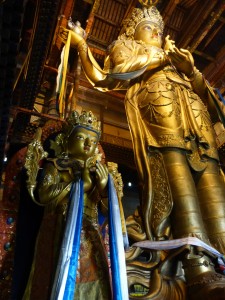
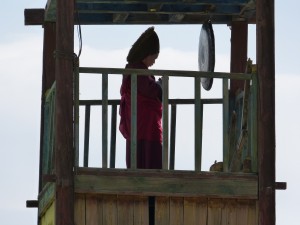
The sound of the chanting put me in the mood for otherworldly music of another sort, the throat singing made famous by the people of Tuva, a region in Siberia just west of Mongolia. Throat singing is also practiced by their cousins all over the world, including the Innuits in northern Canada as well as by the nomadic tribes of Mongolia.
Throat singers are able to generate simultaneous multiple tones in the back of their throats and in their guts, creating an eerie guttural effect that appeals to fans of weird music like me. There was even a time in the 1990s when a famous Tuvan throat singer appeared regularly with the avant garde jazz musicians of downtown New York. This was definitely not jazz of the Wynton Marsalis variety.
I was hoping to hear some throat singing that evening at a concert of Mongolian music and dance, but what we saw instead was a variety show that looked more like Las Vegas than hipster New York, with a bit of Ed Sullivan thrown in for good measure. There were a few minutes of throat singing but not nearly enough to satisfy this cranky critic, though most everybody else in the audience seemed to enjoy the show.
After the concert and dinner we went in search of singing of a different sort, karaoke. Our search took us to the seediest hotel and bar I have ever seen – and that is saying a lot. From the looks on the faces of the men in the lobby wearing sweat stained polo shirts and the women in the bar wearing tacky dresses, all of whom gave us some strange looks as we walked in, we finally figured out that singing was not the main attraction. We quickly left and retreated to our hotel bar for a drink and a few vocalizations about our cultural misadventure.
The next day we drove to Ghorkhi-Terelj National Park a couple of hours north of UB. Aside from a few tourist buses and vans heading in the same destination, there was little traffic. The scenery, mostly rocky hills with clumps of trees, was reminiscent of Wyoming and Montana.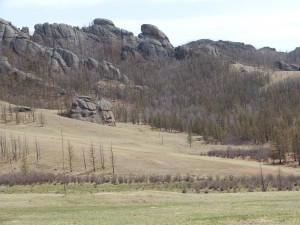
Our destination was one of the many tourist camps of gers (more commonly known as yurts) that can be found in the fields and at the bases of the hills throughout the park. Several members of our group had arrived the night before to spend a chilly but star-studded night.
After a substantial lunch of roast lamb, we gathered outside to watch a folkloric show of wrestling, archery, acrobatics and horse back riding. Oh yes, there were also a few minutes of throat singing, but still not enough to satisfy my throat singing jones.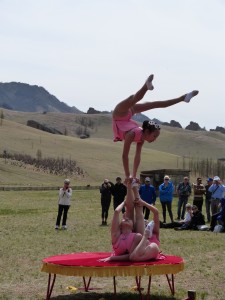
From there we headed to the train for our last night before reaching China. During dinner we were entertained by two musicians from UB – one on a stringed instrument like a miniature cello, the other on a curved wind instrument that sounded like a saxophone. They also sang from the depths of their throats and bellies. It was strange music, but you didn’t have to be a fan of Ornette Coleman or John Cage to appreciate it. Maybe its because the music comes from deep in the body that it literally resonated with everyone there. It was just a few minutes, but the music was so exotic that I was almost satisfied.
Early the next morning, we stopped in middle of the Gobi Desert, our last stop before reaching China. As we stood around looking at the camels and the flat expanse of sand that stretched in all directions, the musicians came out and set up chairs for an early morning concert, with another string instrument, like a lute, instead of the “saxophone.”
I sat on the ground and listened transfixed to the ethereal vibrations of the strings, throats and bellies. My gaze switched from one to the other, from their hands on the strings to their mouths shaping the notes, from the musicians to the camels in the background, and to the infinite expanse of desert beyond. Now this was the Mongolia of my fantasies.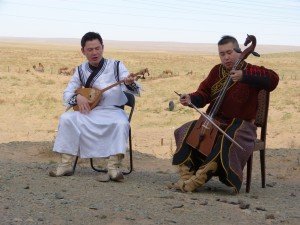
(For more info on trans Siberian travel check out www.transsiberian-travel.com. For more information about our trip see http://www.lernidee.de/en/transsiberian/trans-siberian-railway.html)
